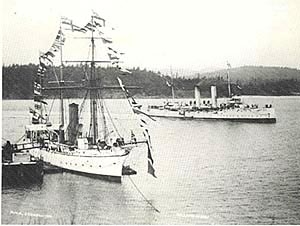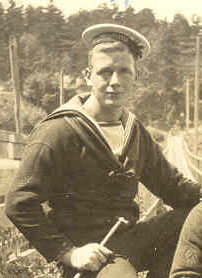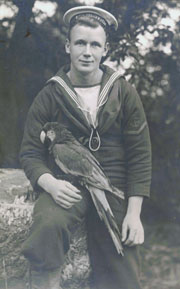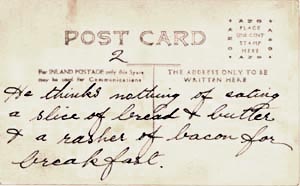The Life of Ryley
With nearly half a century of service, including eight years in the Royal Navy and more than forty years at HMC Dockyard, Robert (Tim) Ryley saw the Canadian Navy develop from its inauspicious beginning, through times of expansion and war.
Tim was born October 23, 1886 at Mansfield, Nottinghamshire, into the large family of Roland and Harriett Ryley. By age 14, he was working as a coal miner. Perhaps his experiences underground made the prospect of joining the Royal Navy attractive; his naval service records show he enlisted soon afterwards, serving on the training ship HMS Ganges. For three years he served with the Home and Channel Fleets, earning qualifications as a Signalman.
On October 24, 1906, the day after his 20th birthday, Tim left for Quebec via the SS Lake Erie. On arrival, he traveled across the continent by train to join HMS Shearwater, which at the time was the only ship of the Pacific Fleet stationed at Esquimalt. He served for two commissions in Shearwater, patrolling from the Bering Sea to British interests on the Pacific coast of South America, while eventually qualifying as Leading Signalman.

HMCS RAINBOW’s arrival at Esquimalt on November 7, 1910 with HMS SHEARWATER in foreground – Photo Catalogue No. VR993.3.8.
Two of Tim’s journals, located in CFB Esquimalt Naval and Military Museum’s archive, provide some fascinating tales and insight into shipboard and dockyard life during this period of the Royal Navy, while illustrating Tim’s buoyant personality. He had a delightful sense of humour, which captured the antics of a pet parrot, and is hinted at in the following excerpt: “Dec. 1st Pay Day. Drew 3$ soon be a millionaire“.
Tim was witness to HMCS RAINBOW, the Royal Canadian Navy’s first ship, arriving at Esquimalt and had the honour, in 1910, of hauling down the British flag at Dockyard for the last time.
He left the Royal Navy in 1910 by “shore purchase” of 12 pounds originally intending, according to his naval records, to take up farming in Canada.
However, Tim stayed on to live at Dockyard for the next two years, working initially as a guard at the main gates and then as the first appointed telegraphist for the base. He stayed at that post for a year before becoming “victualling storehouseman” when the first Dockyard stores were set up.
In 1915, Tim married Helen Ross Apperson at St. Paul’s Church and they lived outside Dockyard in various locations in Esquimalt over their married life. They had a son, Roland, and a daughter, Muriel, but tragically, in 1936, Roland was killed in a motorcycle accident at the age of nineteen.
During his lengthy career at Dockyard, Tim had the opportunity to contribute during both World Wars. With the onset of WWI in 1914, Tim became Signal Instructor to recruits for the Royal Canadian Naval Volunteer Reserve. In peacetime he returned to his storehouseman position, becoming Foreman of Stores, a position he held from 1927 until 1939.
At the outbreak of WWII, Tim applied for leave to offer himself for Active Service in the RCN, but was refused permission “owing to the necessity of retaining his services in his civilian capacity“. He was named Naval Stores Office Representative and for the next five years traveled the west coast extensively, carrying out his duties. One of his responsibilities in 1942 was to find safe storage for the valuable trimmings of the Cunard liner Queen Elizabeth during her conversion to an armed troop carrier at Esquimalt. In 1944, Tim became Naval Stores Officer at Prince Rupert and remained there until the base closed in 1946.
He returned to his responsibilities at Esquimalt and was ultimately appointed Inspector of Stores, a position he held until his retirement in 1951. At that time, Tim and his extraordinary career were profiled in the local papers and the Navy’s magazine, The Crowsnest. Tim and Helen were able to celebrate their 65th anniversary together in 1980 before Helen passed away in 1982. When Tim died in his 98th year in 1984, he was believed to be the last surviving member of the ship’s company of HMS Shearwater.



 CFB Esquimalt Naval and Military Museum
CFB Esquimalt Naval and Military Museum CFB Esquimalt Naval and Military Museum
CFB Esquimalt Naval and Military Museum CFB Esquimalt Naval and Military Museum
CFB Esquimalt Naval and Military Museum CFB Esquimalt Naval and Military Museum
CFB Esquimalt Naval and Military Museum CFB Esquimalt Naval and Military Museum
CFB Esquimalt Naval and Military Museum CFB Esquimalt Naval and Military Museum
CFB Esquimalt Naval and Military Museum CFB Esquimalt Naval and Military Museum
CFB Esquimalt Naval and Military Museum CFB Esquimalt Naval and Military Museum
CFB Esquimalt Naval and Military Museum CFB Esquimalt Naval and Military Museum
CFB Esquimalt Naval and Military Museum